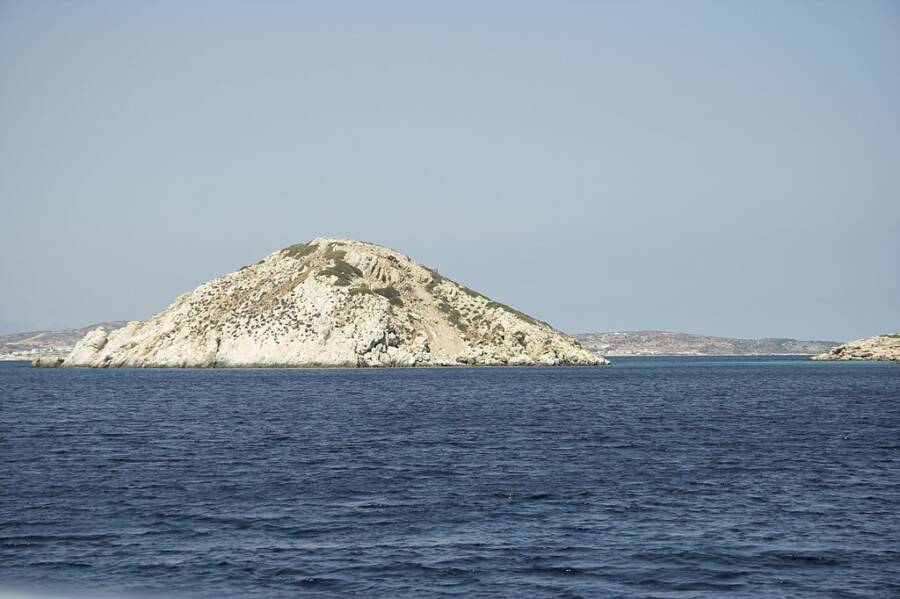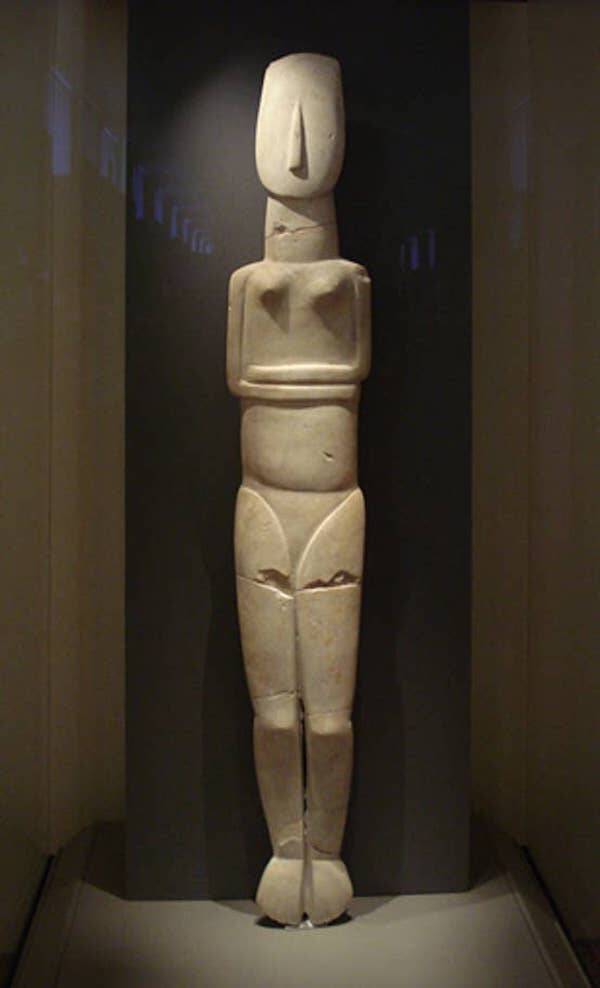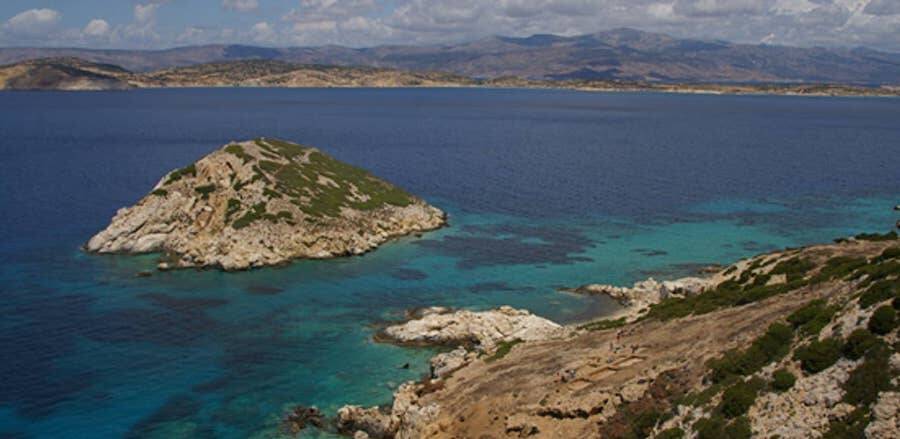4,600-Year-Old Complex On A Tiny Greek Island Is Totally Changing Our Understanding Of Ancient Greece

The tiny islet of Dhaskalio is situated off the larger island of Keros, which is 125 southeast of Athens.
New excavations on the Aegean islet of Dhaskalio are giving archaeologists an entirely new understanding of ancient Greece. According to The Independent, a dig on the small island 125 miles southeast of Athens has revealed a stunning 4,600-year-old complex of buildings.
The complex is situated on the Dhaskalio islet off the island of Keros, and is shaped like a small pyramid-esque mountain peak. Researchers believe the site may have contributed to the core ancient Greek belief that mountaintops were where the gods lived.
The monumental effort required to complete this complex is only now coming into focus. Archaeologists have estimated that it took the Bronze Age Greeks at least 3,500 voyages to get somewhere between 7,000 and 10,000 tons of white marble from one island to another.
This would’ve required up to 24 maritime crew members to paddle for up to five hours. In total, the distance traveled was around 45,000 miles. The end result is what researchers believe to have been an enormous religious sanctuary comprised of about 60 buildings.
The shining white marble used to construct this complex would have allowed the structures to glisten brightly in the sun, resulting in a mesmerizing sight atop Dhaskalio for anyone within viewing distance.
“It is by far the largest prehistoric marine transport operation that has ever come to light anywhere in the world,” said Dr. Julian Whitewright, a maritime archaeologist at the University of Southampton.
“It demonstrates quite clearly just how important, and integral to their culture, seafaring was to these early Bronze Age Agean people.”
This remarkable effort of ingenuity and discipline didn’t end there, however, as the ancient architects of this site had to ensure Dhaskalio was suitable enough an island to contain these structures. Hence, the Greeks “terra-formed” the island’s “mini-mountain” to create around 3,300 feet of artificial terracing.
This additional space was arranged into six “steps,” which were layered down the islet’s precipitous slopes. Experts believe the 20-foot-wide terraces were designed specifically to house these buildings, while the summit remained open and clear.
It’s postulated that this was a small sacred space where the Greeks would make offerings to the gods.

In addition to marble figurines such as these, researchers have found evidence of mass-produced tools and weapons on the islet.
“Our investigation has been transforming our understanding of early Bronze Age Cycladic culture and suggests that these very early Greeks were organizationally, technically, and politically much more advanced than previously thought,” said co-director of the excavation project, Michael Boyd, of Cambridge University’s McDonald Institute for Archaeological Research.
To be clear — nothing like this 60-building complex has ever been discovered from this particular period in or around Greece until now.
Though archaeologists have been researching the site for four years, it’s only in the last 12 months that the complex’s monumental scale — and the logistics of transporting materials and completing construction — has come into focus.
The age of this complex puts it within 100 years of the building of Stonehenge and the first Egyptian pyramids (according to the commonly accepted dates for Ancient Egyptian structures). As such, this site falls in line with the preponderance of metal usage in these areas during that time.

The discovery has shed new light on Ancient Greek beliefs and religion, with the shining white pyramid-shaped complex potentially representing the “primordial mound” of initial life “rising out of watery chaos.”
Similar to those iconic ancient structures, the ancient Aegean people had to partake in dazzling feats of transport and construction in order to create the glistening complex. Up to 10,000 tons of white marble had to be quarried in the southeastern part of Naxos — a larger island about 6.5 miles away.
That means each trip would have required 13 miles of paddling. Additionally, surviving images of Aegean Cycladic ships indicate that each boat was only capable of carrying between one and two tons of cargo. That means they had to complete as many as 10,000 trips.
Of course, after depositing the marble on the islet, the Greeks had to transport it up the mountainside terraces, which were two stories high and up to 33 feet long. Experts currently estimate that this entire project was completed in a remarkably short time, between 20 and 40 years.
Besides the mere feat of engineering, logistics, and organization, all of the gathered data suggests that the political powers in place (either based on Keros or Naxos) were strong and stable enough to accommodate such a project.
The result was a shining white pyramid-shaped mountain, appearing to people miles away as though it was protruding from the sea. Coincidentally, pyramidic shapes were coming into vogue as sacred configurations at this exact same time in Ancient Egypt, 500 miles away.

The world’s leading expert on Greek mountain-top sanctuaries, Dr. Alan Peatfield, believes the Dhaskalio complex to be the origin of Ancient Greek fascination with sacred mountains.
“It is potentially a fundamental place of origin for the phenomenon of sacred mountains within the Greek world,” said Dr. Alan Peatfield of University College Dublin’s School of Archaeology. As the world’s leading expert on Greek mountain-top sanctuaries, his opinion holds weight.
The nearby Ancient Egyptians and Mesopotamians both had creation myths centered around a pyramid-shaped mound rising from the sea — representing the first dry land to emerge from the watery chaos. And the Egyptians covered their pyramid-shaped rocks, or “pyramidions,” with gold, to symbolize the first rays of the sun to ever shine on land — evoking the sparkle of Dhaskalio’s white marble.
Dhaskalio is the earliest such sacred mound ever found in Greece. It’s possible that the idea of a sparkling, pyramid-shaped home of the gods began there, eventually moving to the island of Crete and ultimately to mainland Greece, where Mount Olympus became the official dwelling place of Zeus, Hera, and the others.
As it stands, experts are inspecting 1,500 stone disks, 700 white pebbles thought to have been used as religious offerings, 36 marble statues, evidence of mass-produced weaponry (copper daggers, spearheads, axes, blades), and 1,000 religious marble figurines — all found on the tiny island.
Whether or not this site was intended to symbolize the first days of creation — and the primordial mound used as a sacred site of religious offerings — is certainly up for debate. It will take some more digging — both in the dirt and in the mind — to complete the picture of Dhaskalio’s origins.
Mankind is much older and smarter than we even imagined they were.... The Neanderthals were smart people.....
ReplyDeletemost likely humans were more evolved than previously known . archaeologists only surmise ,based on what little they know.and thats not much.
ReplyDeleteFascinating...
ReplyDelete